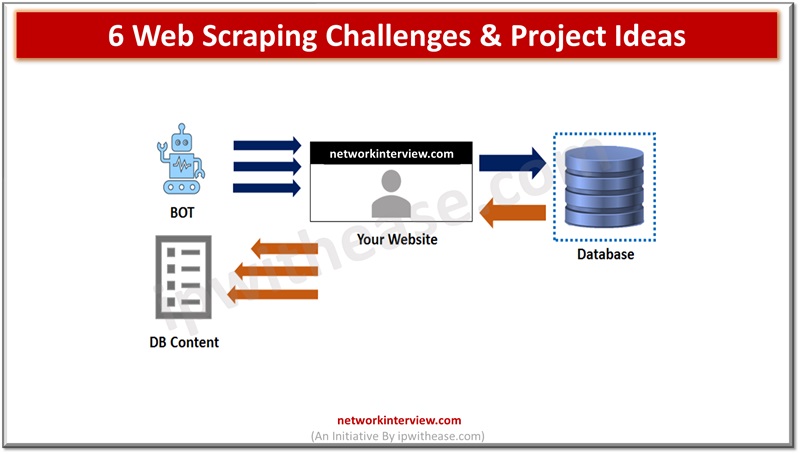
6 Web Scraping Challenges & Project Ideas To Try Out In 2025
Web scraping is a wonderful way of drawing data down from sites and making it practically applicable for all sorts of purposes.
Of course there are hurdles to leap over in this process, and you need an appropriate project to focus your scraping efforts on in the first place.
To that end, here are the main hiccups you’ll need to quash, as well as some ways to work with web scraping to inspire you.
Web Scraping Challenges
Navigating Dynamic Websites
Website navigability often poses a significant hurdle for new web scrapers. For instance, you might tackle the daunting task of realizing how data is loaded dynamically via AJAX calls on JavaScript-heavy websites.
With few constants to anchor your understanding, dynamic websites can seem like moving targets. The challenge of learning to engage these sites effectively and efficiently, while extracting the information you need without getting lost in ongoing updates or changes in structure, requires a combination of the right tools and a healthy dose of experience to overcome.
Coping with CAPTCHAs and Login Requirements
For web scrapers, CAPTCHAs and login requirements create another layer of complexity. Some websites require user authentication to access their data or use CAPTCHA systems as anti-bot measures.
Modulating scraping speed, incorporating delay routines or even creating an entire back-end for automation are exciting challenges you might face while dealing with these protective measures.
It’s imperative to find ethical ways around these obstacles in order to conduct effective data collection. Once again, modern web scraping tools can automate these processes, from defeating CAPTCHAs to encompassing login requirements. You just need to get out there and use them.
Managing Large-Scale Data Collection
Ensuring efficiency in large-scale data collection presents a unique difficulty when web scraping. You may come across websites with massive amounts of data, stretching the limits of your tools and techniques.
Moreover, hosting thousands or even millions of requests can lead to IP bans if not managed correctly. With the help of a web scraping API, creating an efficient means for collecting, storing, and managing this vast amount of data within the constraints of the project and your resources is much easier.
Encompassing IP Blocking and Rate Limiting
IP blocking and rate limiting are common techniques that sites use to discourage scraping. Sites will block an IP if it sends out too many requests in a short period of time, as this is a surefire sign of web scraping.
Similarly, some websites limit the number of requests from one source (rate limiting). Devising a means to circumvent these barriers without breaching any ethics or laws can involve implementing proxy networks or rotating user agents, which are aspects that dedicated web scraping tools can include natively.
Project Idea 1: Building a Price Comparison Tool
A great starter project for web scraping novices is building your own price comparison tool. This lets you try out techniques and tools in real-world applications, giving you valuable practice while creating something useful. Here’s your rough roadmap:
- Choose different e-commerce websites from which the pricing data will be scraped. Aim for a niche that you already understand in order to make the decision easier.
- Use various parsing methods to select and extract specific product prices and details.
- Implement necessary techniques to bypass website defenses against scrapers like logins or CAPTCHAs.
- Continuously update your database with new incoming data for current comparisons.
Ideally you’ll then roll this data into a user-friendly interface that displays the best deal based on real-time scraped data from multiple sources.
Project Idea 2: Analyzing Social Media Trends
Extracting relevant data from social media platforms can be a tantalizing project utilizing web scraping. It’s about tracking trending topics and understanding user behavior for insights across multiple platforms. Here’s a general plan of action:
- Decide upon the key metrics you wish to track, such as hashtags, likes, shares or comments.
- Determine which platforms will offer the most valuable information for your study. FaceBook, Instagram, and X are understandably popular for this purpose.
- Develop techniques to scrape that specific data periodically. Specific scraping tools or APIs are ideal for this purpose, as discussed.
- Analyze and visualize this data in a consumer-friendly format.
Ultimately, this project helps generate perceptible patterns and meaningful information through heaps of online conversations. This can sharpen your technical skills and also add an edge to any future marketing-related endeavors you might carry out, whether for personal purposes or in a professional capacity.
Final Thoughts
As you can see, web scraping is a challenging yet rewarding skill to master. The tests it presents are met with equally exciting project possibilities, making this adventure truly worthwhile. Regardless of how you proceed, you must always respect website terms of service and only scrape publicly accessible information. Failing to do so could land you in hot water, and so simply isn’t worthwhile.
Continue Reading:
Data Crawling vs Data Scraping: Detailed Comparison



